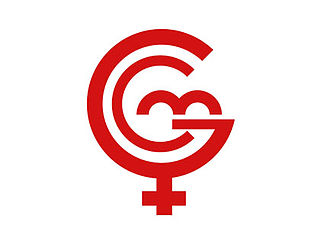
La Générale des Carrières et des Mines (Gécamines) is a Congolese commodity trading and mining company headquartered in Lubumbashi, in the Katanga region of the Democratic Republic of Congo. It is a state-controlled corporation founded in 1966 and a successor to the Union Minière du Haut-Katanga. Gecamines is engaged in the exploration, research, exploitation and production of mineral deposits including copper and cobalt.
Katanga Mining Ltd was a mining company operating in the Democratic Republic of the Congo with its headquarters in Canada. Katanga Mining operated a major mine complex in the Congo's Katanga Province, producing refined copper and cobalt. It claimed to have the "potential of becoming Africa's largest copper producer and the world's largest cobalt producer."
Kinsevere is an open pit mine and Heavy Media Separation plant with an electric arc furnace formerly operated by Anvil Mining, and now operated by Minerals and Metals Group. It is located 30 kilometres (19 mi) north of Lubumbashi, Katanga Province, Democratic Republic of Congo.
Copper mining in the Democratic Republic of the Congo mainly takes place in the Copper Belt of the southern Katanga Province of the Democratic Republic of the Congo.
The Kolwezi tailings project is a major project in the Kolwezi mining area of the Democratic Republic of the Congo (DRC) to recover copper from the tailings, or processed ore, from mining in the region since the 1950s. The project was developed by the Canadian mining companies Adastra Minerals and then First Quantum Minerals between 2004 and 2009, when the DRC government revoked First Quantum's license.

The Kambove mines are a group of active or abandoned copper mines near Kambove in the Democratic Republic of the Congo. They were originally established by the Union Minière du Haut-Katanga under Belgian rule.
Tilwezembe is an open-pit copper and cobalt mine in Lualaba Province of the Democratic Republic of the Congo owned by Katanga Mining, a subsidiary of Glencore. Officially, Glencore has shuttered the mine, but the site is still being used by artisinal miners.
Mutoshi Mine is a copper mine in Katanga Province, Democratic Republic of the Congo. As of 2011 it was 70% owned by Anvil Mining and 30% by the state-owned Gécamines. The mine was placed on care and maintenance in late 2008.
The Etoile Mine is an open-pit copper mine on the outskirts of Lubumbashi in Katanga Province of the Democratic Republic of the Congo (DRC). Chemaf owns the license. Chemaf is 95% owned by Shalina Resources and 5% by the DRC government.
The Kamoto Mine is an underground copper and cobalt mine to the west of Musonoi in Katanga Province, Democratic Republic of the Congo. As of 2022, the site is the largest active cobalt mine in the world. The exploitation rights are owned by the Kamoto Copper Company (KCC), a joint venture between Katanga Mining (75%) and the state-owned Gécamines (25%).
Luishia mine was an open pit copper and cobalt mine in Katanga Province, Democratic Republic of the Congo. A concession to the south of the mine has recently been opened to exploitation.

The Dikuluwe Mine is a copper and cobalt mine in Katanga Province of the Democratic Republic of the Congo. Dikuluwe is the westernmost of the Diwa Pit group, with Mashamba West and Mashamba East. The quarry was opened in 1975 and was planned to be connected to the nearby Mashamba West pit.
Kalukundi Mine is a copper and cobalt mine being developed in Katanga Province, Democratic Republic of the Congo (DRC) by Africo Resources, a Canadian company. In September 2008 the company estimated the value of the resource as $1.47 billion.
Africo Resources was a Canadian mining company whose main property is the copper and cobalt Kalukundi Mine in Katanga Province, Democratic Republic of the Congo. A majority of the company was acquired by Camrose Resources Limited in 2016.
Tremalt Limited was a mining company incorporated in the British Virgin Islands which owned assets in the Democratic Republic of the Congo (DRC). It was the vehicle for a highly criticized deal in 2001 in which it bought copper assets at far below their estimated value in return for a private agreement to pay a share of profits to the DRC and Zimbabwe governments. Allegedly some of the payments were made in the form of military equipment. The company made few investments in its assets, several of which the DRC government took back. In 2006 it was sold for about $60m.
Dan Gertler is an Israeli billionaire businessman in natural resources and the founder and president of the DGI group of companies. He has diamond and copper mining interests in the Democratic Republic of the Congo (DRC), and has invested in iron ore, gold, cobalt, oil, agriculture, and banking. He may also hold citizenship of that country. As of 2022 his fortune was estimated at $1.2 billion by Forbes.
Nikanor plc was a publicly quoted holding company for Global Enterprises Corporate (GEC) with assets in the rich Copperbelt region in Katanga Province, Democratic Republic of the Congo (DRC).
The Kananga Mine is an open pit copper mine near Kolwezi in Katanga Province, Democratic Republic of the Congo. It is currently officially inactive.
The Mutanda Mine is an open-pit copper mine in the Katanga Province of the Democratic Republic of the Congo. The largest cobalt mine in the world, Mutanda has been closed since November 2019. The owner of the mine, Glencore, has announced it plans to resume production in early 2022.
Camrose Resources Limited (Camrose) was a company owned by Dan Gertler, an Israeli businessman, the founder and President of the DGI Group of Companies. Camrose's other assets included a "64% stake in Canada listed Africo Resources which held a 75% interest in the Kalukundi Mine's exploitation licence as well as a 56% indirect interest in Comide Sprl, which held the exploitation licence for Mashitu, Pangalume and Kii tenements."



